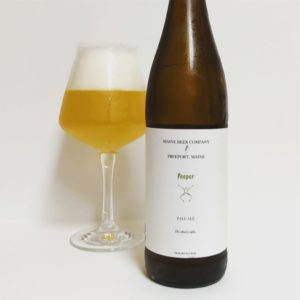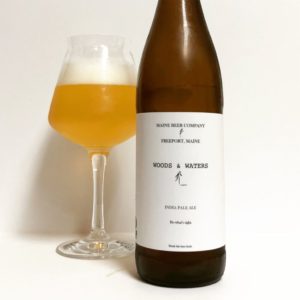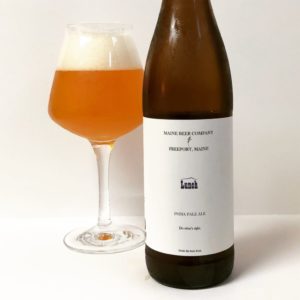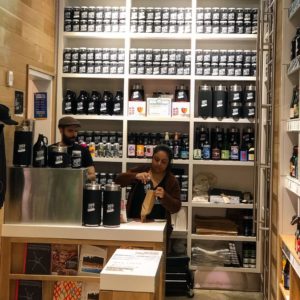
Editor’s Note: This biweekly column is sponsored by Dominion Wine and Beer (107 Rowell Court, Falls Church). It is written by Garrett Cruce, a Cicerone Program Certified Beer Server.
David Kleban’s 2006 dream to open a brewery eventually came true when he and his brother, Daniel, started Maine Beer Company (MBC) in 2009. Starting super small — nano small — they perfected a single beer: Peeper Pale Ale. Eventually they outgrew their original location.
In nearly ten years, they have grown into their own space with a production of around 13,000 bbls a year. That’s in a local market where they are one of 99 breweries, which actually makes Maine ranked 3rd in the nation for breweries per capita.
Every bottle of MBC beer sports the motto: “Do what’s right.” It’s more than just a nice thought, too. They decided early on to make more than beer. By joining an organization called 1% for the Planet, they committed to making a difference. One percent of MBC’s sales goes to 1% for the Planet, where it is distributed to local environmental charities.
I had my first bottle of Lunch — MBC’s famous whale of an IPA named after a whale — in 2013. At the time, there were fewer than 5,000 breweries in the U.S. The New England IPA as a hazy, fruity juice bomb with a velvety mouthfeel was not a national craze. Lunch was a sought after beer.
Instagram and other platforms allowed beer drinkers in parts of America where MBC didn’t distribute to learn about it. And want it. MBC is still here, and even if they aren’t part of whatever fad is happening they show that quality and conviction can lead to success.
I have three classic Maine Beer Company releases to share today. Three beers that have remained vital to MBC and to beer drinkers alike.
Starting as Spring Peeper Ale in 2009, MBC worked on their recipe for a pale ale until they had it just right. More than being part of a line of flagship beers, this is the beer that started it all.
Pouring a dark straw color with a generous and creamy head, Peeper gave off an enticing aroma of rice cereal, peach and green apple, and celery. The sip is clean and crisp with a fruity — white grapefruit and unripe plum — middle that coincides with the hint of bitterness that lingers after the sip is over.
I’m happy to see that, among the hazy, sometimes sweet IPAs that are prevalent, the good old pale ale seems to still have a place. It hearkens back to a time when the pale ale was a staple beer for most breweries.
At 5.5%, you can enjoy this as the summer months get into the super humid time. Named for the frogs that come out in the warmer months, providing a chorus for the nighttime, Peeper is perfect for this time of year.
Brewed in honor of the establishment of the Katahdin Woods and Waters National Monument in Maine, Woods & Waters is made using barley and wheat grown in Maine.
The aroma is tangerine and fresh pine sap. The sip is light and citrusy with an earthy finish that is punctuated by a prominent pine resin flavor.
Neither clear nor hazy, this crisp beer refreshes and pleases at the same time. Woods & Waters is effervescent and flavorful without any sweetness.
It’s perfect for sitting on the deck and watching the fireflies.
If you don’t turn the bottle to read the rest of the label or visit MBC’s web site, you might be like me and wonder why this storied IPA is named after the midday meal.
Well, if you did turn the bottle or visit the web site, you’d learn that it is actually named for a whale that is know for having a chunk of its fin missing. Now, Dinner, their DIPA IS actually named for the evening meal because it’s more serious than lunch. Right?
Inhale as the head dissipates, and you’ll get an aroma of cantaloupe, mandarin orange and evergreen. Mmmm.
After smelling sweet fruit, the sip is unsweetened and crisp with a bitter finish. As with Woods & Waters, this IPA goes down easily albeit with a slightly herbal hop bite.
With all three of these Maine Beer Company beers, a common refrain is the lack of sweetness — whether perfectly sessionable at 5.5% or on the strong for an IPA side of 7.0% — and the clear and precise flavor notes. Like craft breweries two- and three-times as old, quality and consistency win the day.
This Week’s Beer Tasting
Dominion Wine & Beer is having Foreign Objects Beer for their beer tasting on Friday, August 10 from 5-7 p.m. with two new IPAs! Dominion will have both growlers and cans available of both.

Editor’s Note: This biweekly column is sponsored by Dominion Wine and Beer (107 Rowell Court, Falls Church). It is written by Sarah Garratt, a wine and food pairing blogger. Follow her blog or on Instagram @grapepairings.
Riesling… a white wine that is a wine aficionado’s dream.
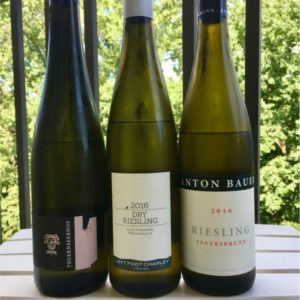 It is one of the best white wines for food pairing and has one of the most unique flavor profiles that wine writers love to decipher. However, much of the world is left either confused or just don’t know about the wonders of Riesling.
It is one of the best white wines for food pairing and has one of the most unique flavor profiles that wine writers love to decipher. However, much of the world is left either confused or just don’t know about the wonders of Riesling.
This is why one New York sommelier and restaurateur, Paul Grieco, created an annual event called “Summer of Riesling.” Every summer, Mr. Grieco refuses to sell any white wine by the glass in his restaurant and wine bars except Riesling.
There are two dozen wines to choose from, but if you want a Chardonnay or Sauvignon Blanc, you won’t be able to order it by the glass.
Why? Mr. Grieco wants to show the world how expressive and wonderful the grape can be.
Well, what does a New York sommelier have to do with us? We agree with Mr. Grieco! Riesling is one of our favorite white wine grapes, too, and we are carrying on the tradition. This week’s WWBG showcases three fabulous Riesling as to why we love it!
Riesling is a white wine grape that is mostly grown in Germany; however, it can be grown in any cool climate. France, Austria, the US and Australia/New Zealand are some other areas where it is commonly grown.
Contrary to popular belief, Riesling is not just a sweet wine. Yes, it can be made to be very sweet, but there are many bone dry examples, as well as everything in between. It is almost always acidic and floral, but depending on where the wine is from, expressions of apple, pepper or mango can be found.
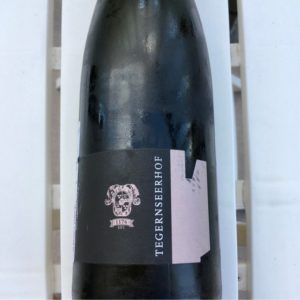 Our first example of a bone-dry, fantastic Riesling is the 2015 Tegernseehof Bergdistel Smaragd Riesling from Austria ($30).
Our first example of a bone-dry, fantastic Riesling is the 2015 Tegernseehof Bergdistel Smaragd Riesling from Austria ($30).
With lots of citrus, honey and minerality, this wine would be perfect for a summer strawberry chicken salad or a juicy BLT with farmer’s market fresh tomatoes.
This wine is extremely limited right now. The only 10 cases in the US can be found at Dominion Wine & Beer or their sister location in Maryland!
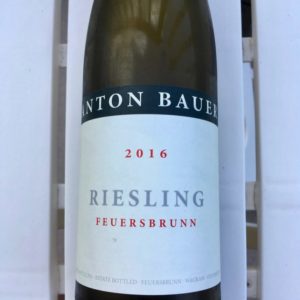
Another Austrian Riesling that we are featuring today is an Anton Bauer 2016 Riesling Feuersbrunn ($22).
Anton Bauer recently won winemaker of the year in Austria, and after tasting this wine, you’ll know why.
Citrus, peaches, cream, and honey are very apparent, and yet, this is still a dry example of a Riesling. The citrus explodes in your mouth, and the honey and cream notes balance it out at the end. Curries were made for this wine, especially if it is made with seafood!
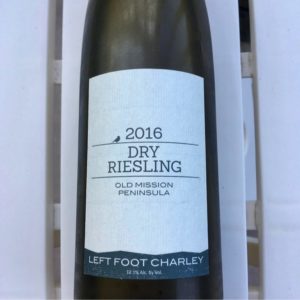 Lastly, we travel to somewhere a tad more local. The 2016 Left Food Charley Dry Riesling from Michigan ($22) is a wonderfully acidic Riesling with lots of character.
Lastly, we travel to somewhere a tad more local. The 2016 Left Food Charley Dry Riesling from Michigan ($22) is a wonderfully acidic Riesling with lots of character.
Lime and peach flavors hit you upon smelling, and are balanced out with some honey and apple flavors on the palate.
Your favorite Asian foods would do well with this, whether it be Chinese takeout, Vietnamese Pho, or a spicy Thai stir fry.
Don’t forget to visit Dominion Wine & Beer this Saturday from 1-4 for their wine tastings, and pick up some of these wines so that you can have your own Summer of Riesling!

Editor’s Note: This biweekly column is sponsored by Dominion Wine and Beer (107 Rowell Court, Falls Church). It is written by Garrett Cruce, a Cicerone Program Certified Beer Server.
You’ve probably heard of Prairie Artisan Ales’ coffee stout — Bomb! — which can be hard to get when released. It sits at number 106 on Beer Advocate magazine’s current list of the 250 Top Rated Beers along with five other Prairie beers. This week, I’m taking a look at three of their current releases.
In 2012, Oklahoma-based Krebs Brewing Company started brewing under the name Prairie Artisan Ales. The goal was to create a brewery that was adventurous, that pushed the boundaries. Making their name on strong stouts and farmhouse sours, Prairie also stood out on shelves and in social apps with their bold, colorful labels.
A year ago, they began canning with their coconut and vanilla flavored imperial stout, Paradise. While not every beer they produce is canned, I want to share a few that are. Happily, they’ve carried over the eye-popping artwork to these beers.
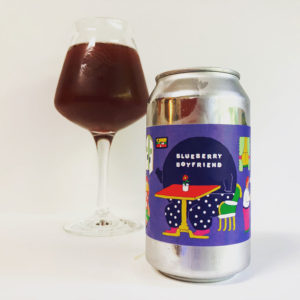 Blueberry Boyfriend, sour ale with blueberries and lemon zest (5.4% ABV)
Blueberry Boyfriend, sour ale with blueberries and lemon zest (5.4% ABV)
I have not had the pleasure of exploring Prairie’s offerings, sour or otherwise. So, I had no idea what to expect with this blue sour.
The aroma was a mix of blackberries and blueberries with a tang of malt vinegar and a bright lemon juice. The flavor is tart with a short, fruity sip that doesn’t linger with an aftertaste.
The purple-blue color is spot on with this refreshing sour. Blueberry Boyfriend reminds me more of a tart blueberry lemonade than a sour ale as any maltiness is masked until it warms a bit. Even then it’s only evident at the end of the sip. This is a lovely sour for those who don’t care for the style.
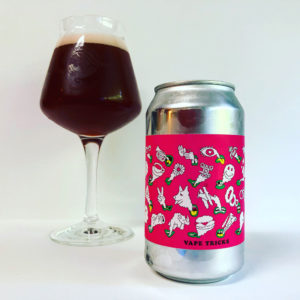 Vape Tricks, sour ale aged on cherries (5.9% ABV)
Vape Tricks, sour ale aged on cherries (5.9% ABV)
First, how awesome is that wine red color?
Inhaling, I get sour cherries, baking soda and lemon. The sip is slightly tart with a good cherry flavor that ends with a lightly sweet maltiness.
Wine red in color, this refreshing sour looks like it tastes.
This is a relatively simple beer — perfect for backyard hangs. Whether you pour it into a glass, a Solo cup or drink it straight from the bright pink can, Vape Tricks is perfect for Summer.
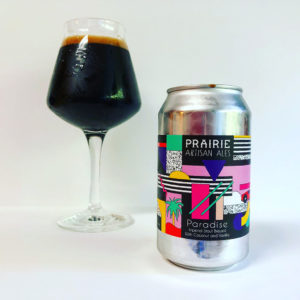 Paradise, imperial stout with coconut and vanilla (13.0% ABV)
Paradise, imperial stout with coconut and vanilla (13.0% ABV)
When I saw this, I immediately thought of Maui Brewing Company’s Black Pearl imperial coconut porter. It makes sense — they’re both dark beers brewed with coconut. But that is where the similarities end. Paradise is dessert in a glass.
I was reminded of a magic bar — there’s some chocolate and coconut and a whole lot of vanilla. I got licorice, toffee, toasted coconut and s’mores in the aroma. But the flavor was all sugary vanilla upfront with chocolate, coconut and a slightly bitter finish.
Paradise is best savored sip by sip — especially considering the 13% ABV.
This Week’s Beer Tasting
Join Dominion Wine & Beer on Friday, July 13th from 5 to 7 p.m. at their weekly beer tasting with Bell’s Brewery, Old Ox Brewery and Dogfish Head Brewing Company. And don’t forget your growler for a fill-up from the rotating options.
Editor’s Note: This biweekly column is sponsored by Dominion Wine and Beer (107 Rowell Court, Falls Church). It is written by Sarah Garratt, a wine and food pairing blogger. Follow her blog www.grapepairings.com or on Instagram @grapepairings.
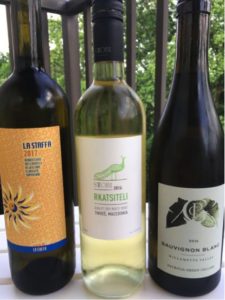 In case the heat and humidity haven’t given you a clue, summer is finally here!
In case the heat and humidity haven’t given you a clue, summer is finally here!
Time to put away your red wines and break out your whites. Yes, many people like to enjoy rosés during the warmer weather (and we do, too!), but let’s not forget about the many refreshing white wines that can cool us off!
When many people think white wines, they often think of the most common three: Chardonnay, Sauvignon Blanc, or Pinot Grigio. However, did you know that there are well over 200 different white grape varietals? Today’s WWBG features two varietals that you may not have heard of, plus one that you have.
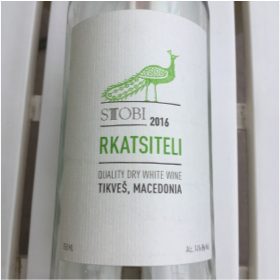 The first grape that we are featuring today is Rkatsiteli (pronounced R-cat-set-el-ee). It is originally from the country of Georgia, but is now grown all over Eastern Europe.
The first grape that we are featuring today is Rkatsiteli (pronounced R-cat-set-el-ee). It is originally from the country of Georgia, but is now grown all over Eastern Europe.
It is known for being zesty and tart, which makes it great for dry or sweet wines.
Stobi’s 2016 Rkatsiteli from Macedonia ($11.99) is a dry wine. It is bright with acidic flavors of lemon and grapefruit that are well balanced with green apple and spearmint. It’s acidity make it a great pairing with creamy cheeses such as blue cheese or gorgonzola. Any summer salad would be delicious with this as well!
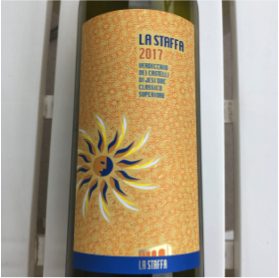 Traveling west to Italy, we learn about our second featured grape, Verdicchio (pronounce ver-dee-ck-io). Verdicchio comes from the word verde, which is Italian for green. The wine is called “Verdicchio” due to the grape’s green color. This grape is also known for being acidic, but not as much as the Rkatsiteli.
Traveling west to Italy, we learn about our second featured grape, Verdicchio (pronounce ver-dee-ck-io). Verdicchio comes from the word verde, which is Italian for green. The wine is called “Verdicchio” due to the grape’s green color. This grape is also known for being acidic, but not as much as the Rkatsiteli.
La Staffa’s 2017 Verdicchio dei Castelli di Jesi Classico Superiore (Regularly $16.99, on sale for $14.99) has a beautiful nose of Asian pear, peach, and clementines, with woodsy notes coming at the end. On the palate, there is a little zing coming from the fruit. Grilled veggies and fish were meant to go with this dish, so it will definitely be a winner at your next barbecue or cookout!
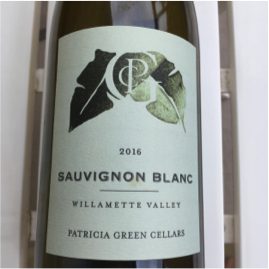 Lastly, we feature a grape that you have all heard about: Sauvignon Blanc.
Lastly, we feature a grape that you have all heard about: Sauvignon Blanc.
However, this may be one of the most versatile grapes around! It can have a lemongrass-y, acidic taste that many people enjoy from New Zealand. It can be more tropical when coming from California. From France, it could be more floral with mineral elements to it.
The Sauvignon Blanc we are featuring today is from Oregon, which is a nice blend of Californian and French styles.
The Patricia Green Cellar’s 2016 Sauvignon Blanc from Willamette Valley, Oregon ($24.99), is unlike many Sauvignon Blancs that you have had before. The smell alone is full of tropical notes like pineapple, mango, and lychee. However, there is also something that will leave you curious to try more. It is an herb? Is it hay? Is it floral? Grab some next time you are in the shop and figure it out with us! It will go perfectly with your next grilled chicken or sushi!
Editor’s Note: This biweekly column is sponsored by Dominion Wine and Beer (107 Rowell Court, Falls Church). It is written by Garrett Cruce, a Cicerone Program Certified Beer Server.
After a long, rainy Spring we seem to be crawling into Summer. We thought it would be a good time to look at some refreshing beers to enjoy as the weather turns warmer.
These three beers have one thing in common: they’re perfect for enjoying in the heat of the afternoon on your deck or patio. Ranging from sour to slightly sweet and malty, these three beers are perfect for days with more sunlight than moonlight. Though not necessarily seasonal beers — though one is — this time of year is ideal for all three.
I recently wrote about the first beer below, but, now that it’s actually warming up, it’s worth another look.
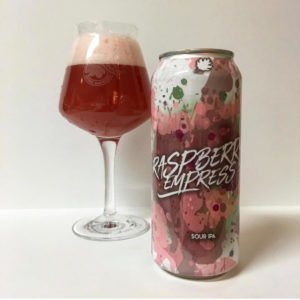 Raspberry Empress Kettle Sour IPA (6% ABV)
Raspberry Empress Kettle Sour IPA (6% ABV)
The first thing you have to do when drinking one of these is take in that guava pink color — made possible by the raspberries used in the brewing process. Then go ahead and inhale deeply — you’ll find an aroma of berries and Pinot Grigio with a distinct earthiness.
Sour IPAs can be exciting beers. For one thing, they tend to be slightly less tart than most sours. And, it’s interesting to taste how the hops interact with the sourness.
In this case, the beginning of the sip is distinctly fruity and tart. Midway, that fruit is offset by a bitter herbal flavor right before finishing with a biscuity malt. This is a tasty and flavorful sour that would be a welcomed beverage on a hot summer day.
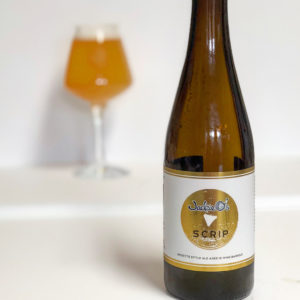 Jackie O’s Scrip Grisette Style Ale Aged in Wine Barrels (4.5% ABV)
Jackie O’s Scrip Grisette Style Ale Aged in Wine Barrels (4.5% ABV)
Apart from beer, the word “grisette” means “young working woman” and typically referred to women who worked in urban factories, as opposed to those who worked on farms. Think of a grisette beer as a counterpart to a saison or farmhouse beer.
These beers were brewed for industrial workers. In fact, Jackie O’s has named this beer after the factory town currency that was only good at the company store.
Scrip uses only saison and brettanomyces yeasts. It ferments for 2 months in stainless tanks and is then transferred to oak wine barrels for another 9 months.
Where the Raspberry Empress is kettle soured — made sour in the brewing process by the introduction of lactobacillus bacteria — a sour like Scrip is made using brettanomyces yeast and then aged to allow the “wild yeast” to change the beer.
This complex beer has an aroma of saltine crackers and lemon pulp with an astringent edge. The sip is light — both in mouthfeel and sourness — but flavorful.
Up front you get bitter orange and unripe pineapple with a healthy dose of earthiness, while saison yeast cuts the tartness. Enjoy this as the evening begins to cool slightly — this beer is both light and flavorful.
Editor’s Note: This biweekly column is sponsored by Dominion Wine and Beer (107 Rowell Court, Falls Church). It is written by Arash Tafakor.
Rosé is huge in the states. I don’t need to tell readers that.
Most social gatherings, rosé is as common as a local craft beer. And why not? rosés are super drinkable, bone dry, with little to no sweetness, and can pair with any food you can imagine.
I literally had one with a PB&J sandwich the other day, and it was life changing.
The good news is rosé is here to stay and there’s a second wave of rosés coming into the market.
The past few years it feels like every winery in the world is now producing a rosé. Apothic, Kendall Jackson, rosé in boxes and even 40-ounce bottle rosés! You should find a bigger and better rosé section at any wine store.
With the flooding of rosés in the market, consumers have gotten more discerning when it comes to quality. Wineries have stepped up their rosé game and started producing enough to make them available year-round so they don’t get lost in the shuffle.
This is great news for wine drinkers, quality and quantity of producers.
Even though there’s been amazing rosés being produced for years, one trend that is starting to gain traction in the main stream is to sit on these delicious wines for a few years as opposed to just drinking the most current vintage.
A well-made rosé can last several years after it was bottled and will certainly get better with age.
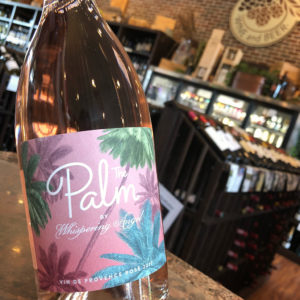 An example of a winery producing a new rosé that is high in quality is the “The Palm” Rosé by Whispering Angel 2017 from Provence, France.
An example of a winery producing a new rosé that is high in quality is the “The Palm” Rosé by Whispering Angel 2017 from Provence, France.
Whispering Angel, which is one of the best-selling rosés in the world, decided to make a second label. “The Palm” is actually cheaper and quite honestly just as good if not better than its more expensive counterpart.
Don’t take my word for it, my friend Hoppy buys a case of it every few weeks. I told her to sit on a case for the next year or two, but that seems impossible.
Another trend in wine that is gaining a lot of traction is wine in a can.
Like most consumers I was hesitant/skeptical about drinking wine from a can. This comes from a bias that wine out of a can is of low quality, and to be honest, when canned wines first came out a few years ago they tasted like crap. Read More

Editor’s Note: This biweekly column is sponsored by Dominion Wine and Beer (107 Rowell Court, Falls Church). It is written by Garrett Cruce, a Cicerone Program Certified Beer Server.
New Brewery Profile: Rocket Frog Brewing Company
Location: 22560 Glenn Dr., Suite #103, Sterling, VA
Opened: May 5, 2018
Twin brothers David and Richard Hartogs partnered with David’s wife, Jennifer Showell-Hartogs to open the uniquely named Rocket Frog Brewing Company. They brought in their TV producer brother, Peter Hartogs, as an investor and Ph.D. in biochemistry, Russell Carpenter, as head brewer.
The Arlington-natives, David and Richard, have worked in and around beer for years between The Better Beer Authority beer review video series on YouTube and a craft beer meet up group called Beer Head on meetup.com. Now, they get to make the beers that they want to drink.
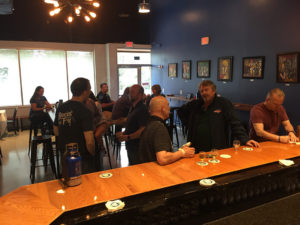 They’ve built a tap room for today’s beer drinkers with charging stations for phones and other devices, coat hooks galore and plenty of gathering space for hanging and trying their line up of beers. They’re hoping they can find their niche in the beer-rich LoCo.
They’ve built a tap room for today’s beer drinkers with charging stations for phones and other devices, coat hooks galore and plenty of gathering space for hanging and trying their line up of beers. They’re hoping they can find their niche in the beer-rich LoCo.
I reached out to co-owner Richard Hartogs with some questions to figure out just what a “rocket frog” is and where they’re planning to go with the brewery.
What Is a “Rocket Frog”?
“September 6, 2013, a frog was propelled in the air by the Minotaur V rocket on Wallops Island, VA as the boosters blasted the rocket to space. The frog basically photo bombed a NASA photograph and it gained media attention. I thought Rocket Frog was a funny name and suggested it to David. He said yes. It turns out the rocket was made by Orbital ATK, a mile from the brewery.” Read More

Editor’s Note: This biweekly column is sponsored by Dominion Wine and Beer (107 Rowell Court, Falls Church). It is written by Garrett Cruce, a Cicerone Program Certified Beer Server.
Lagers are truly the king of beers in the United States, if not around the world.
For years now, craft breweries have tapped into an already lager-hungry cross-over market offering traditional styles that contrast with hoppy or sour beers.
A well-made craft lager or even traditional import can be a refreshing alternative to the glut of ales on the market. Often low in ABV, though not always, and crisp and malty rather than heavy and fruity — they make the perfect addition to the Summer cooler.
At it’s root, the thing that sets a lager apart from an ale is the yeast. Ale yeast requires warmth in order to start the fermentation of sugar into alcohol, adding fruity flavors to the beer. Because ales are made at warm temperatures, the yeast remains near or at the top of the wort as it makes the beer — ales are also known as “top fermenting beers.”
Lager yeast actually begins fermentation at lower temperatures and is slower to complete it. That slower fermentation also happens at the bottom of the tank, giving lagers the designation of bottom fermenting beers. The result is a crisp, clean flavor that should be free of the fruitiness that ales display.
The word lager is derived from the German word “lagern,” which means “to store.” In fact, lagering is the process of storing the beer at temperatures around or below freezing for a period of time. Lagering allows the few flavor compounds created by the slow fermentation of the lager yeast to reabsorb and be processed out.
All the lagers that I’m exploring are relatively light in color, but they can also be brown or black as the yeast and the lagering is what makes a lager a lager and not the grain or the color.
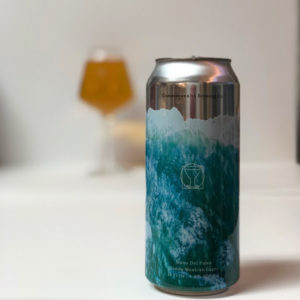 Mano Del Puma Blonde Mexican Lager (4.8% ABV)
Mano Del Puma Blonde Mexican Lager (4.8% ABV)
Mexican lagers are made by adding corn to the grain bill, which adds sweetness and contributes to the crispness that you get with beers like Corona or Dos Equis. Mano Del Puma is a simple, but delicious brew.
Inhaling, I get fresh herbs like parsley and cilantro bracketed by clean, white flour. The sip is crisp soda cracker with a subtle sweetness.
It’s all on point. At only 4.8% ABV this is great for a hot summer day after mowing the lawn or grilling. This isn’t just crushable, it’s totally poundable. Read More

Editor’s Note: This biweekly column is sponsored by Dominion Wine and Beer (107 Rowell Court, Falls Church). It is written by Garrett Cruce, a Cicerone Program Certified Beer Server.
Last Friday, Dominion Wine & Beer hosted Commonwealth Brewing Company for their weekly beer tasting. The Virginia Beach brewery was in the area to promote their upcoming beer festival and to share some recent, limited releases.
Lucky customers had a chance to win two tickets to Commonwealth Brewing Company’s 3rd Annual COMMON GROUNDS Collaborative Beer Fest & Camp Night on May 19 from 4-8 p.m.! This event will feature collaborations with some of the best breweries in the country, including Aslin Beer Company and Ocelot Brewing Company.
In addition to flagship favorites, Aureole Lager and Big Papi DIPA, Commonwealth shared limited releases Tinta Rosa Gose, Lethe Pale Ale and There Goes Gravity IPA.
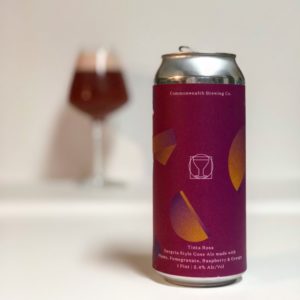 Tinta Rosa Sangria Style Gose Ale (5.4% ABV)
Tinta Rosa Sangria Style Gose Ale (5.4% ABV)
The fourth entry in Commonwealth’s international street vendor drink series, Tinta Rosa is a gose in sangria’s clothing.
The purple coloration is the first clue that this beer might be just what they promise. While the aroma of lime and green plums doesn’t scream sangria, it does evoke a good gose.
They nailed the sangria flavor in the sip! Though it starts out extremely tart and sharply salty — as a good gose will — the orange and raspberry comes through evoking the fruited wine drink.
For fun, I’d pour several cans into a chilled pitcher with some fruit to complete the illusion. We may not be able to keep our warm days around, but Tinta Rosa was a welcomed beer on a recent warm day. Grab a four pack and hold on to it for when Spring finally returns. Read More
Editor’s Note: This biweekly column is sponsored by Dominion Wine and Beer (107 Rowell Court, Falls Church). It is written by Garrett Cruce, a Cicerone Program Certified Beer Server.
On any trip to New York City, I try to get to my favorite watering holes and to find new ones.
Recently, I visited the Big Apple with my family. While there, I decided that I’d like to share my favorite restaurants and bottle shops for grabbing a beer.
Whether you’re waiting in long lines to get into the Supreme store in SoHo or in the long lines to get into the 9/11 Memorial & Museum or are waiting to get into the next showing of Hamilton — you’re probably going to want beer when you’re done.
(22 Grand Central Terminal, Across from Track 13 and WESTFIELD WORLD TRADE CENTER, 185 Greenwich Street)
My first stop was Beer Table in Westfield World Trade Center.
This small space had quite the singles selection with five beers on tap for filling in a variety of vessels that range from pint jars to mini kegs called “Gregs” — a contraction of growler and keg.
I couldn’t pass up a jar of Runcible, a Brett IPA from DC’s Right Proper Brewing Company. My literally pint-sized jar came cozily wrapped in a complimentary koozie and sealed well enough that the longish walk back to my hotel without immediate refrigeration did little to diminish the freshness.
As small as the Lower Manhattan location is, the one at Grand Central is even tinier. But show up on a Friday evening and you’ll find a line that stretches out their door and down the corridor. Thirsty commuters looking for some tasty beer for their train rides out of the city keep this location hopping!
They have big plans for the future, too. Their origins were in the restaurant business with a now-closed Beer Table restaurant in Greenpoint, Brooklyn. Now, they’re returning to their roots with Beer Table Coffee Table on Third Avenue between 45th and 46th Streets.
While You’re In The Neighborhood…
When in the Financial District, be sure to grab a bite — and maybe some groceries — at Eataly.
Conveniently located upstairs from the Beer Table in Westfield World Trade Center, you’ll find a lot of Dogfish Head beers (they have collaborated on beers in recent years) and beer from an Italian craft brewery, Baladin. While I didn’t manage to try Baladin’s beer, they do make delicious sodas that we all fell for. Read More
Editor’s Note: This biweekly column is sponsored by Dominion Wine and Beer (107 Rowell Court, Falls Church). It is written by Garrett Cruce, a Cicerone Program Certified Beer Server.
Opened in 2013, this Charlottesville, Virginia brewery drew upon the historic surroundings for their name and inspiration.
Their name — Three Notch’d — a peculiarly spelled moniker is derived from the old road that leads to Charlottesville. The road was made famous in 1781 by Jack Jouett, who rode it sounding the alarm that the British were advancing.
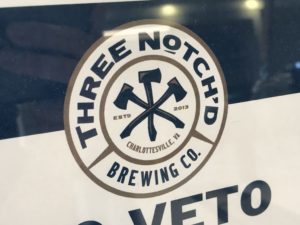 Three notches, like small slashes, mark the road. They used to also mark Three Notch’d Brewing Co., but recently they rolled out a complete rebrand. Three Notch’d ditched the slashes and historical looking fonts in favor of a clean, modern take on the historical references. They’ve also added bottles to their packaging options.
Three notches, like small slashes, mark the road. They used to also mark Three Notch’d Brewing Co., but recently they rolled out a complete rebrand. Three Notch’d ditched the slashes and historical looking fonts in favor of a clean, modern take on the historical references. They’ve also added bottles to their packaging options.
I reached out to Jack Murray, the Brand Manager at Three Notch’d to shed some light on the big changes we’re seeing. I wanted to find out more about this new design and whether they plan to phase out cans in favor of bottles. He started by explaining the new mark of three axes:
“The three crossed axes represent the tools used by Colonists to mark the original Three Notch’d Trail in Virginia. Symbolically the tools represent three values our business strives for everyday — Radical Independence, Freedom of Expression and Civic Responsibility. We hope our new mark grows our community and inspires them to live everyday to the fullest.”
Why redesign now?
“Three Notch’d has been continually and rapidly expanding both our product line and our distribution/locations since our launch in 2013. As is the case with many brands, as we’ve grown, our brand has evolved and over the course of the past year or so, we discussed the idea of refreshing our design elements to reflect this evolution.
“Most importantly, we wanted to tie the ‘red thread’ throughout our products and locations to create consistency for our customers, so that whether they are drinking a Minute Man, 40 Mile or new Blackberry Gose at a bar in Northern Virginia or visiting one of our locations in Richmond, C’ville, or Harrisonburg — or soon to be opened (in) Roanoke — they identify their experience as something unique to Three Notch’d. And, the timing of our rebrand nicely coincided with the opening of our new production facility and craft kitchen at IX Art Park in the heart of Charlottesville.”
Who did you work with on the redesign?
“We worked with local artists and designers on the redesign. We enlisted the original artists to re-create the illustrations on our Flagship cans to better suit the new look, and had a local designer create the system template from which to work with. Each new packaged beer is then designed to suit the product by an in-house team.” Read More


